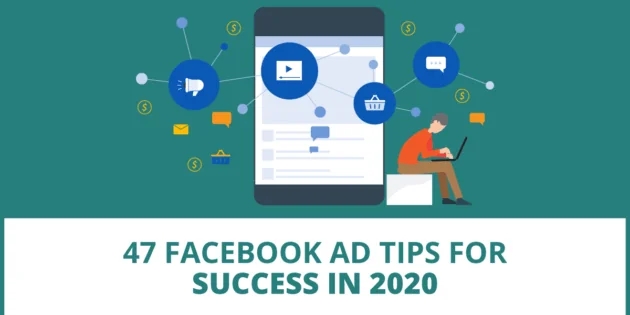
47 Facebook Advertising Tips for Success in 2022
Looking to crush it with Facebook ads in 2022? These 47 Facebook advertising tips will definitely help…
#1 Video, Video, Video, Video
All things being equal, video ads on Facebook outperform regular image ads and other ad formats.
There are notable exceptions, as you can see from Facebook advertising tip 9, but for the majority of businesses, video content will win.
This is particularly the case with service based businesses.
Educating your target market as a service provider can be incredibly effective for establishing your industry expertise and acquiring clients.
As a Facebook advertising agency, videos like this have generated a lot of our business:
That’s not the only application for video ads either.
Customer testimonial videos can work very well in a wide variety of industries.
I’m also a big fan of product demonstration videos for new or innovative products.
And there’s a lot of value in entertaining your target market.
Dollar Shave Club have done this brilliantly:
#2 Use Automatic Placements Most of the Time
When you advertise on Facebook, there are a number of different placements to choose from:

A placement simply refers to where your ad is displayed.
All placement options are not created equal. Some placements get much better results than others.
Facebook recommends that you select Automatic Placements when you create your Facebook ad campaigns, and I would agree with them most of the time.
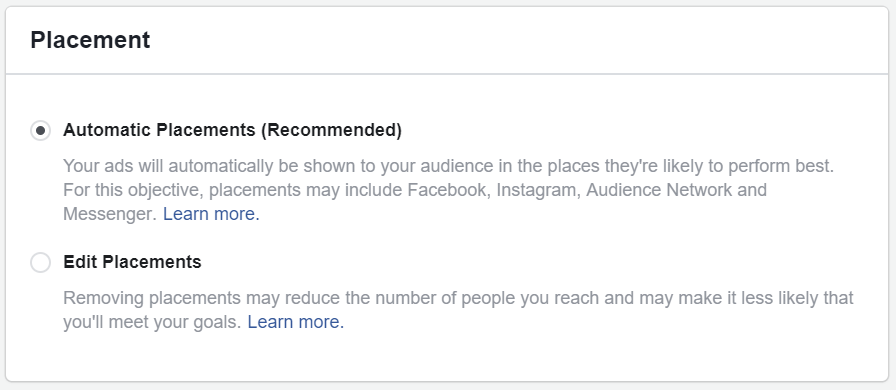
If you’re running a campaign using the conversions objective, automatic placements will usually give you the best results.
That’s because Facebook will optimise your campaign to generate the highest number of conversions and that includes putting your ads in locations where people are more likely to convert.
If you are using the traffic objective, or another non-conversion based objective, I would just start with the feeds and stories placements instead.
But as I mention later in the post, most Facebook advertisers should be using the conversions objective.
#3 Take Full Advantage of the Facebook Pixel
This is one of the most important Facebook advertising tips in this article. Installing the Facebook Pixel on your website is an absolute no-brainer.
With it installed, you can track the actions people take on your website and you can use it to retarget website visitors.
More and more Facebook advertisers are using the Facebook Pixel, but a lot of them have simply installed the base code.
This is a great start and does provide some really valuable data, but to accurately determine crucial KPIs such as cost per purchase and cost per lead, you need to add event code.
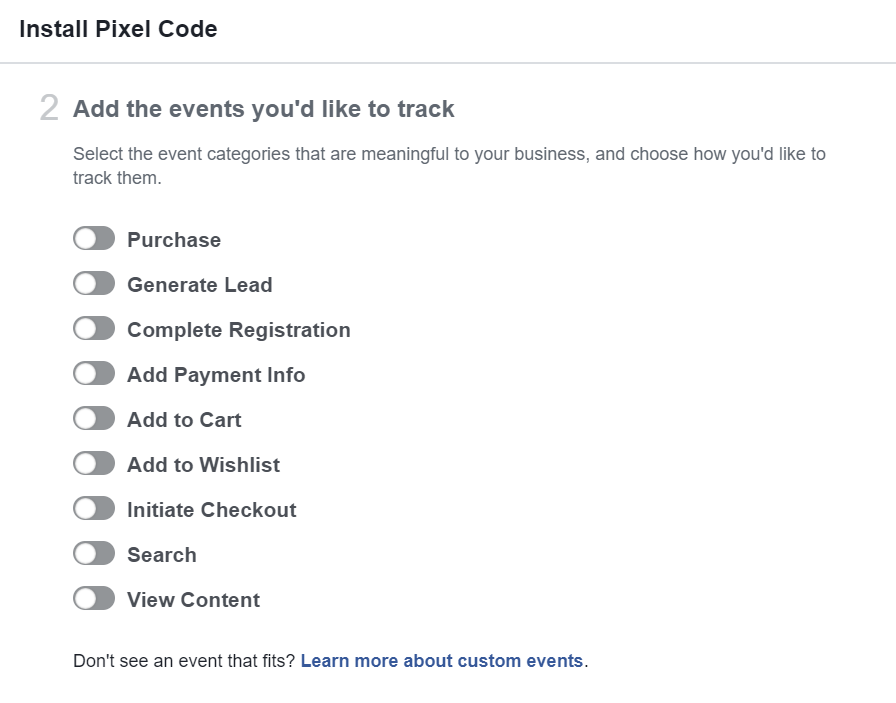
Event code should be added to the thank you pages that people are taken to after they perform a specific action.
If someone inquires via your website then the thank you page should contain lead event code, as you can see here:

That way, leads will be recorded inside your Facebook ad account. Which allows you to instantly determine your cost per lead and see which campaigns, targeting options, ads, etc. are delivering the best results.
This in turn makes it really easy to optimize your campaigns and get more out of your ad budget.
If you’re not very technical, the easiest way to install the Facebook Pixel is to use an online sales funnel tool like ClickFunnels (aff. link).
#4 Target Your Hyper-Responsive Prospects with Custom Audiences
Most Facebook advertisers spend hours researching various demographic, interest and behavioral targeting options.
But that’s not where most businesses are going to find their best prospects.
The hyper-responsive prospects for most businesses, are people that already know that business.
These could be previous and existing customers, website visitors, Facebook page engagers, app users, etc.
Advertising to these warm audiences nearly always delivers better results than advertising to cold audiences.
You advertise to these people by creating custom audiences. There are a number of options when it comes to creating custom audiences:

A great place to start is existing customers (Customer File) and website visitors (Website Traffic).
Custom audiences are my go to, whenever I want to advertise a new offer.
[feature_box style=”10″ only_advanced=”There%20are%20no%20title%20options%20for%20the%20choosen%20style” alignment=”center”]
FREE TRAINING: 3 Killer Facebook Ads Strategies To Double (Or More!) Your Revenue!
In this free training, I demonstrate 3 Facebook Advertising sales funnels that I’ve used to generate 7+ figures repeatedly for our clients.
[/feature_box]
#5 Build a Facebook Group
Organic reach on Facebook has all but disappeared.
Only a small percentage of your Facebook Page likes will see your un-sponsored posts.
However, that’s not the case with Facebook Groups. With Facebook Groups you can still be seen by A LOT of people from free.
As a result, building your own Facebook Group is often tremendously valuable.
I have more than 120,000 Facebook Page likes but my 29,000 person strong Facebook Group is a lot more valuable to my business:
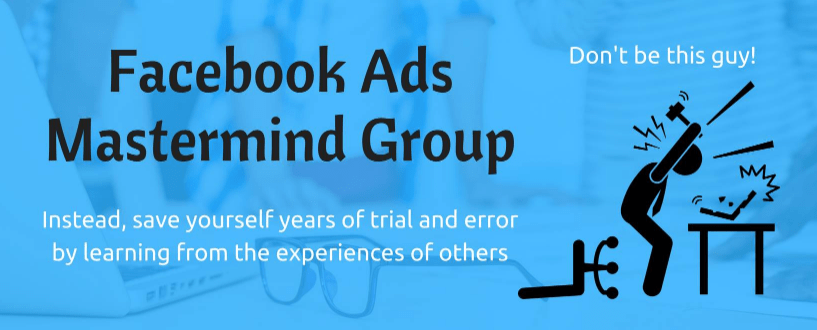
Here’s the good news…
It’s not difficult or expensive to build a Facebook Group. I show you exactly how to build a Facebook Group in this step-by-step article.
#6 Dedicate 10% of Your Budget to Brand Building
Everyone wants to quickly generate leads and sales from their Facebook ad campaigns. And there’s nothing wrong with that.
But that doesn’t mean you shouldn’t dedicate a small portion of your budget to longer term brand building campaigns.
I think most businesses should dedicate at least 10% of their ad budget towards building a brand on Facebook.
That’s because a loyal following makes every Facebook ad objective so much easier.
To effectively build brands on Facebook I use the CBR Method, which I explain in detail, in this video:
#7 Use Facebook Lookalike Audiences
Without Facebook lookalike audiences, the ad platform would be much less effective.
A lookalike audience consists of a group of people that are very similar to another group of people.
This is fantastic for Facebook advertisers, because you can take a list of leads or a list of customers, upload that to Facebook and use it to create a lookalike audience.

Advertising to people that are very similar to your existing customers is (obviously!) incredibly effective.
You need at least 100 people in your source audience to create a lookalike audience. But as soon as you do, make sure you add lookalike audiences to your Facebook ad campaigns.
This video provides step-by-step instructions on how to create lookalike audiences on Facebook:
TIP: Don’t worry if you’re struggling to work out which targeting options you should be using on Facebook. The best cold audience targeting option is nearly always a lookalike audience, which you can start targeting as soon as you have generated 100 conversions. With a reasonable budget, that shouldn’t take too long.
If your cost per conversion is a bit high before you start targeting lookalike audiences, it won’t have much of an impact on the long term profitably of your Facebook ad campaigns.
#8 Get Specific with Your Retargeting Campaigns
I have already mentioned that you should be targeting custom audiences in this Facebook advertising tips article.
And when you do retarget those people, it’s best to get as specific as possible.
For example, instead of just retargeting all website visitors on Facebook, why not retarget people with specific offers, according the actions they have taken on your website.
You can retarget people that have visited specific pages on your website. This works really well when people visit specific product pages but do not purchase.
Or you can target previous customers that have not made a purchase from you in the past 3 months.
You can even retarget people that have added products to a cart on your website but not yet bought.
This type of retargeting campaign is the Facebook advertising equivalent of shooting fish in a barrel.
#9 Sell eCommerce Products with Carousel Ads
In my experience the best Facebook ad format for directly selling eCommerce products is carousel ads.
I explain why in this video:
#10 Use the Right Facebook Advertising Sales Funnel for YOUR Products & Services
One-size-fits-all doesn’t work with Facebook Advertising.
You need to use the right strategy for YOUR products and services. If you sell $30 products or $30,000 services, that is likely to be very different.
To help you establish which strategy you should be using and how to customize that strategy for your business, I have created a free training:
3 Killer Facebook Ads Strategies To Double (or More!) Your Revenue
It’s one of the best resources I have created. If you want better results from Facebook Advertising – this is a must watch!
#11 Use an Appropriate Ad Budget
If your Facebook ad budget is too big or too small then you’re going to run into difficulties.
An budget that’s too large will cause Facebook ad frequency issues, particularly if your target audience is small.
Once everyone in your target audience has been served your ad multiple times, your campaign’s effectiveness is obviously going to drop off significantly.
Alternatively, if your ad budget is too small, you simply won’t generate results.
If your average customer value is $2,000 don’t spend $5 per day on ads and expect it to generate customers more than once in a while.
To help you set an appropriate Facebook ad budget you can check out this article:
How to Set a Facebook Ad Budget
#12 Don’t Forget About Facebook Page Likes
It’s true that Facebook Page likes aren’t as valuable as they used to be.
But that doesn’t mean they don’t have ANY value.
If you’re advertising on Facebook, I think it’s important to look the part. If your Facebook Page has a couple hundred likes or less, you aren’t going to look very credible.
My Facebook Page has over 120,000 likes. When someone checks out my Facebook Page (more people do this than you think) I look like an established presence on the platform.
This undeniably helps me convert those people into paying clients and customers.
In this video, I should you how to quickly, easily and cheaply acquire thousands of Facebook Page likes:
#13 Use the Facebook Pixel Helper Google Chrome Extension
This is a very simple Facebook advertising tip but one that saves me a lot of time.
There’s a Google Chrome extension called Facebook Pixel Helper.
It’s a simple and useful tool that shows you if the Facebook Pixel in installed on a page and which event code, if any, is present.
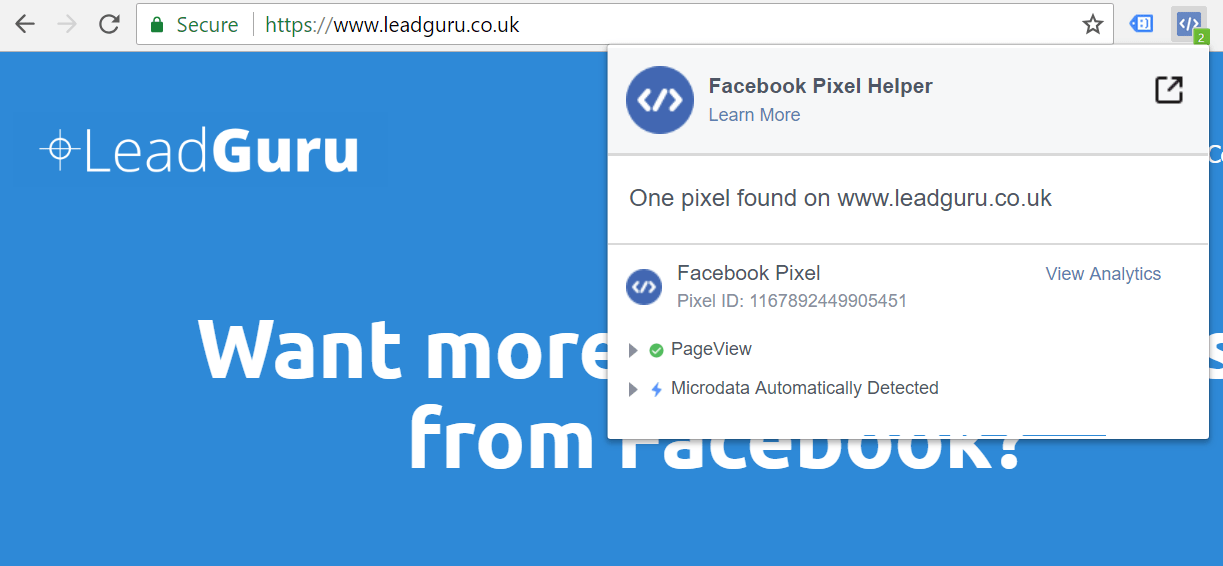
I use it to make sure the Pixel is installed correctly and to save myself a lot of time. Not having to check a page’s code is a big deal when you’re running a lot of campaigns for a lot of clients!
#14 Start a Conversation with Your Prospects via Facebook Messenger
Facebook Messenger marketing is a massive opportunity for a lot of businesses.
It’s a lot more personal and a lot more engaging than other forms of Facebook marketing.
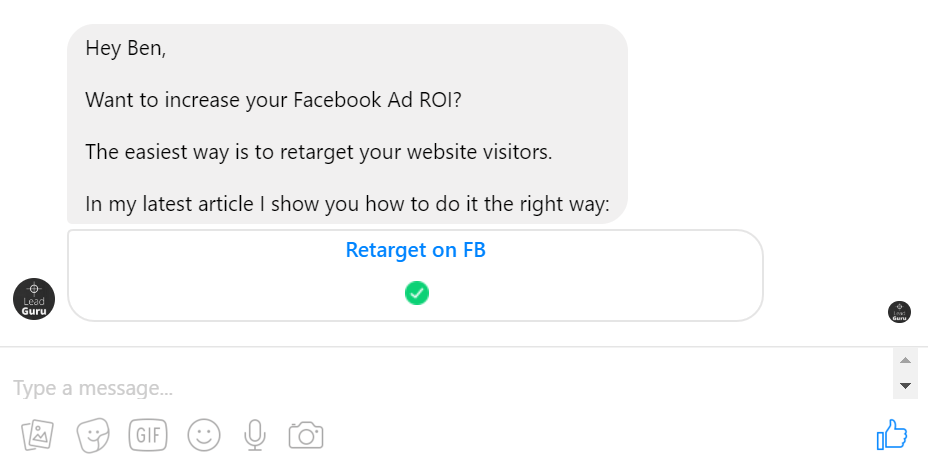
Prospects often have a couple of questions that they need answered before they are ready to buy. Particularly if the product or service is expensive.
Facebook Messenger is a great place to start a conversation with your prospects and overcome any objections they may have.
Of course, doing this is fairly labour intensive (unless you set up a Facebook chatbot – which isn’t really starting a conversation at all). Which means it will be more effective for businesses with high average customer values.
#15 Take Advantage of Campaign Budget Optimization
Campaign Budget Optimization (CBO) is a Facebook advertising feature that should not be ignored.
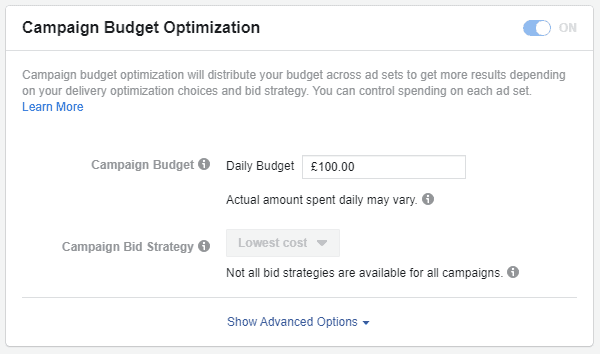
With CBO you can set your budget at the campaign level. As opposed to the ad set level.
This might sound fairly trivial but it isn’t.
Setting your budget at the campaign level means that Facebook will optimise your budget across different ad sets. This will result in more of your budget being spent on the target audiences that deliver the best results.
Automatically spending more of your budget on high-performing elements of your Facebook ad campaigns is a no-brainer.
It will definitely lead to more conversions and a lower cost per conversion.
#16 Use the Lowest Cost Bid Strategy
Not many Facebook advertisers are aware of this but there are currently 2 different Facebook ad bidding strategies.
They offer the Lowest Cost and Target Cost bid strategies.
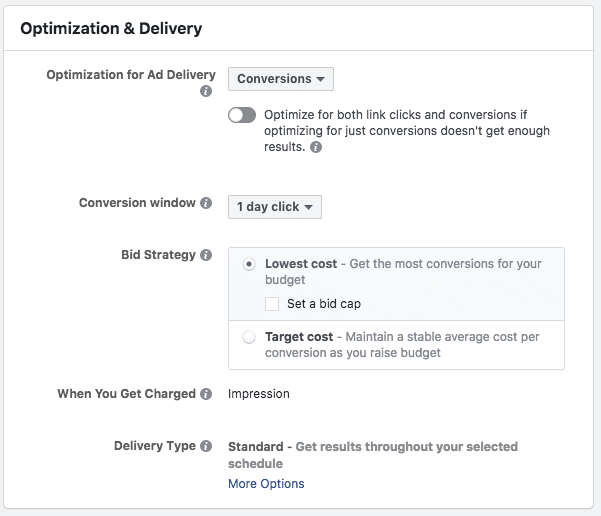
Lowest Cost is the default bidding strategy so the vast majority of Facebook campaigns are using the Lowest Cost bidding strategy anyway.
But Facebook tell us that Target Cost is the bid strategy to use if your looking to scale a campaign or run it for a long time.
I’ve had mixed results testing it and I think most campaigns should stick with the Lowest Cost bid strategy for now.
#17 Keep an Eye on Ad Frequency
If your ad frequency gets too high, your Facebook campaign’s results will start to drop off.
Ad frequency refers to the number of times your ad has been served to members of your target audience on average.

I usually start to see diminishing returns when ad frequency reaches 2.0-2.5.
If your campaigns are not performing as well as they used to, check out this blog post for 3 ways to combat Facebook ad frequency.
#18 Price Discounts Get People to Take Action
A lot of businesses are reluctant to drop their prices, and with good reason.
Price reductions eat into your profit margin and they can affect how people perceive your brand.
But if you want to acquire a lot of buyers quickly, price reductions work really well.
At the end of the day, everyone loves a bargain.
I’m often surprised at just how effective a “20% discount for the next 3 days” promotion is.
And in some industries, you can offer some serious discounts:
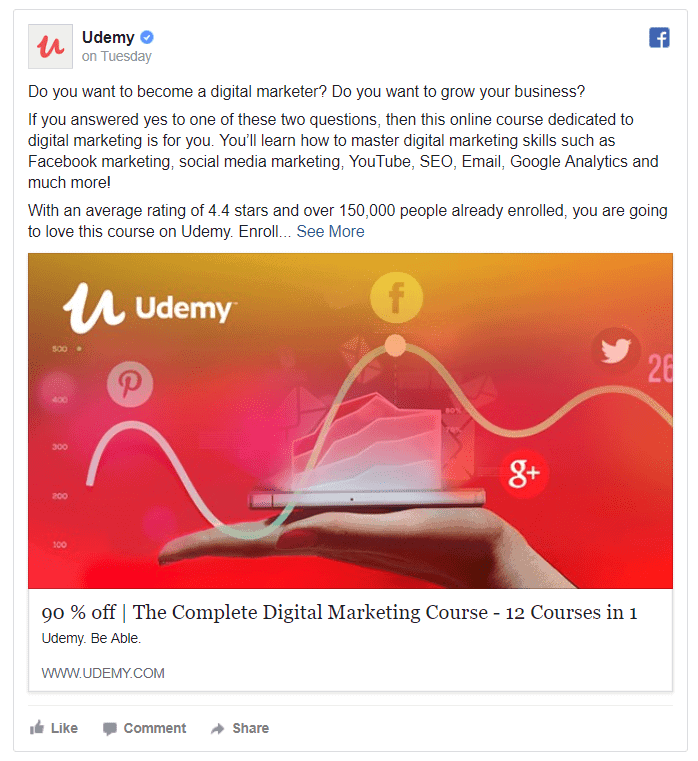
#19 Use Facebook to Build an Email List
This sounds like a bit of a strange Facebook advertising tip but hear me out.
Every time you advertise to your target market on Facebook you have to pay for the privilege.
If you can convert some of your target market into email subscribers, you can market to them on an ongoing basis for free.
If you want to know how to convert prospects into email subscribers using Facebook ads, I have recorded a very in-depth video that shows you exactly how I do it:
#20 Offer Something People Actually Want
This probably should have been one of the first Facebook advertising tips in this post.
It sounds very obvious, and including it might seem pointless but I would argue that it isn’t.
I talk to a lot of small business owners advertising on Facebook. When they tell me their ads aren’t converting, the first thing I ask is whether or not they have been able to sell their offer anywhere else.
If they haven’t, that’s a bad sign.
It’s easy to get lost in the weeds of Facebook’s Ads Manager and forget that unless you’re offering something truly valuable, your campaigns are not going to work.
#21 Use the Right Ad Objective
Facebook currently have 13 different ad objectives and which one you select determines how Facebook runs your campaign.
Facebook’s advertising algorithms are highly sophisticated.
If you tell Facebook that you want traffic, Facebook will try to get you as many link clicks as possible.
If you select the conversions or reach objective, that’s what Facebook will try to get you.

Basically you want to treat this list like a menu. Just select the option that best describes what you’re after.
If you’re looking for leads or sales, make sure you select the conversions objective.
[feature_box style=”8″ only_advanced=”There%20are%20no%20title%20options%20for%20the%20choosen%20style” alignment=”center”]
Would you like us to create, manage and optimise Facebook ad campaigns for you?
To find out more about our services and how we can help, click here to book a free 30-minute strategy session.
[/feature_box]
#22 Test Different Hooks in Your Ads
The hook in your Facebook ad refers to the main reason why people would want to buy what you’re offering.
Will it make your customers’ lives easier?
Will it save them time? Or Money?
Or change the way they feel about themselves?
There are many different hooks that you can use in your Facebook ad copy. But a lot of people get stuck using just one.
You might think that people primarily buy your product or service because of 1 particular reason but that probably isn’t the case for a lot of your target market.
This is one of the most difficult Facebook advertising tips to implement but it can make all the difference.
I would recommend you create multiple ads with different hooks and see which performs best – you might unearth a gem!
#23 Follow Up with Lead Generation Ad Responses ASAP
For those that don’t know, Facebook have a specific ad format for generating leads.
With Facebook lead ads, prospects are asked to submit their contact information within Facebook, instead of being directed to a business’ website.
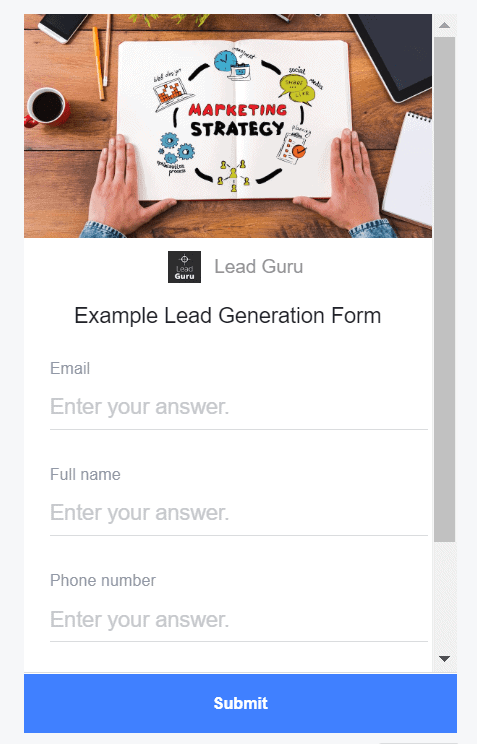
Facebook also prefills the users’ contact details in lead generation forms which makes it really easy for people to become a lead.
However, because it is so quick and easy for people to become a lead, they are not necessarily excited about the company or the services being offered.
For the best results, follow up with your lead ad responses as soon as possible and preferably over the phone.
If you wait until the next day or longer, you’re likely to hear crickets.
#24 Don’t Give Up Too Early
Facebook advertising is a skill. And just like any other skill, it takes time and practice to develop.
A lot of people think that Facebook will either work for their business or it won’t. That’s very unlikely to be the case.
A well crafted Facebook advertising sales funnel will work for the vast majority of businesses. What that looks like for your business will depend on the products and services that you offer and the industry you’re in.
Just make sure you don’t decide Facebook advertising doesn’t work after 1 campaign. 5 million advertisers can’t all be wrong.
#25 Spy on Your Competitors’ Facebook Ads
Working out what delivers results in your industry can be time-consuming and costly.
If you have competitors that you know are generating great results with Facebook ads – why not model from what they are doing?
With the Facebook Ad Library tool, you can take at anyone’s Facebook ads!
You can even see how long they have been running for and where those ads are sending people.
Being able to spy on your competitors’ Facebook Ads is awesome and this video shows you exactly how to do it:
#26 Use the Callout Method
Half the battle with Facebook ads is grabbing your audiences’ attention.
The Callout Method does that very effectively. Here’s an example:

Right at the beginning of the ad copy above you can see that I have “called out” exactly who this ad is for.
This interior design company knows that people get in touch when they are moving house or redecorating. And this ad copy is really going to grab the attention of people who are in the middle of one of those two activities.
The Callout Method can also help fix targeting issues.
No matter how sophisticated Facebook’s targeting options become, it’s not always possible to create a target audience that only contains your ideal customers.
The Callout Method lets your target audience know exactly who your ad is for.
#27 Don’t Distribute Ad Budget Evenly
It’s simple to set aside a monthly budget for Facebook ads. And because of that, most companies that advertise on Facebook spend roughly the same amount every month.
But that doesn’t really make sense because the majority of companies have busy seasons and quiet seasons.
As a Facebook advertising agency, we know our busiest period for acquiring new customers is Q1. Whereas the summer and December tend to be very quiet.
A lot of B2C companies are the complete opposite.
It’s not uncommon for lead or purchase costs to change by 50% or more, depending on the time of year.
Therefore, it makes a lot of sense to save ad budget during the low season and spend extra during the high season. Your long-term ROI could be greatly improved as a result.
#28 Structure Your Facebook Ad Campaigns the RIGHT Way
Where possible, I like to make Facebook advertising simple. Complexity does not equal effectiveness (in fact the opposite is often true).
One of the areas in which you can simplify things, is with your campaign structure.
Structuring your Facebook ad campaigns the right way, not only improves performance but saves you a lot of time when it comes adjustments and optimization.
My preferred campaign structure is a bit difficult to explain but easy to demonstrate. I do so in detail, in this video:
#29 Use Scarcity in Your Ad Copy
This Facebook advertising tip makes me a little uncomfortable but I had to include it.
If you can include scarcity in your ads, you will increase your response rate and often dramatically.
No one wants to miss out on a great deal. And that FOMO (fear of missing out) is a massive motivator.
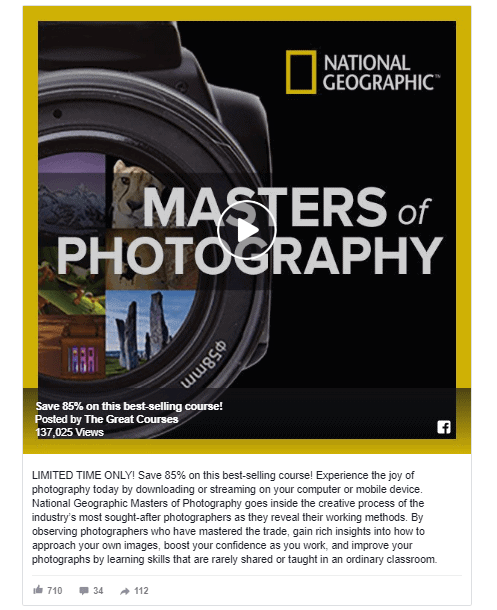
Your prospects will tell themselves they can buy your product tomorrow or next week or when they’re ready, unless they have to buy it now.
However, exercise caution with this tip. If you do it too much it will affect your long term credibility.
And make sure that the offer really does go away when you say it will.
#30 Monitor Ad Relevance Score
Facebook ad relevance score is a number from 1-10 that shows how well your ad is being received by your target audience.
There are a number of factors that determine your ad relevance score including positive and negative feedback. And it’s a very important number.
Not only does it show how your ads are performing but it also determines how much Facebook advertising costs you.
Facebook wants to encourage advertisers to create interesting and engaging ads. That way their users will have a better experience on the platform.
They do this by rewarding ads that have high relevance scores (8+) with lower CPMs (cost per thousand impressions) and doing the opposite with low relevance scores.
If you want to know more about Facebook’s ad relevance score, check out this video I recorded:
#31 Include Emojis in Your Ad Copy
Facebook advertisers are slowly coming around to using emojis, but they’re still underappreciated. Facebook is not a professional network and should not be treated like one, even if you’re a B2B advertiser.
Including emojis in your ad copy will not make your ads look unprofessional and can really help improve their performance.
Getting noticed is the first job any ad has to do, to succeed. Emojis can really help your ads stand out in the Facebook newsfeed.
Here’s an example of ad copy that includes a number of emojis:
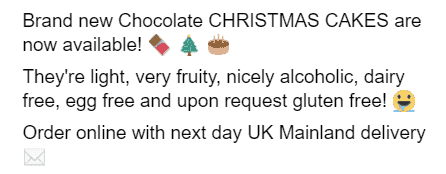
And here’s the exact same ad copy without emojis:
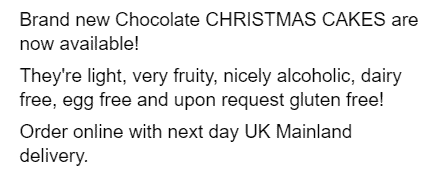
It’s very obvious which version is more likely to grab people’s attention.
The emoji version is also a lot more fun and engaging which is very important. Facebook users will quickly turn their attention to something else if they find an ad boring.
You can easily include emojis in your ad copy as well. Simply head over to emojipedia.org, find the emoji that you want to use, then copy and paste its code into your ad.
Here’s what it looks like:
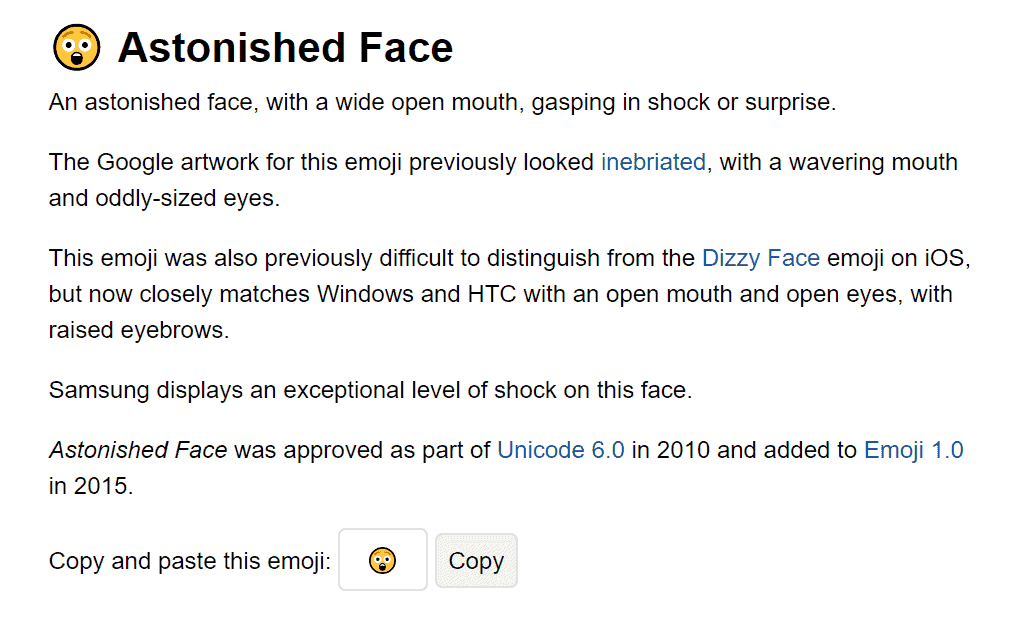
A word of warning – it’s easy to overdo it with emojis. If you do, you’ll struggle to get your ads approved, and your ad copy can become difficult to understand. And if your ad copy isn’t easily understood, your ads will not perform very well.
#32 Use UTM Parameters
Google Analytics and the data you see within in Facebook’s Ads Manager very rarely match. And this has caused a lot of Facebook advertisers a lot of frustration.
Which data should you trust? And which should you use to analyse and adjust campaigns, report to clients or managers, etc.
Well, if you add UTM parameters to your Facebook ads, they can make your life a lot easier.
It’s easy to do as Facebook have an optional URL parameters entry field in the Tracking section:
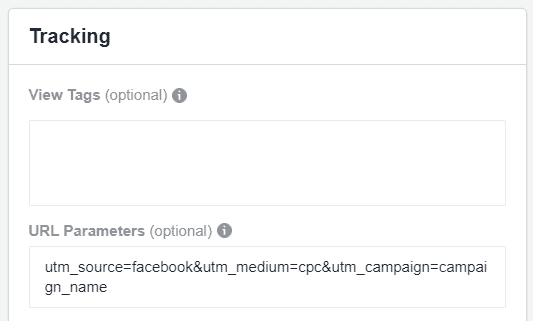
In the screenshot above I’ve added source, medium and campaign UTM parameters.
This data will feed through into my Google Analytics account and provide much more reliable tracking information.
This Facebook ads tip takes a few seconds to set up and is well worth doing because it allows you to use Google Analytics as your data authority.
#33 Don’t Adjust Your Facebook Ad Campaigns During the Learning Phase
The Facebook ads learning phase is a really important Facebook advertising feature and one that you should not ignore.
During the learning phase, Facebook experiments with your ad delivery and works out who within your target audience is most likely to take your desired action.
The learning phase usually lasts a few days and it’s important that you don’t make any significant adjustments to your campaigns during that period. If you do, the learning phase will be restarted, and it will take your campaigns longer to optimise.
Here’s a short video that provides a bit more information on the Facebook ads learning phase:
#34 Create an Omnipresence Retargeting Campaign to Sell Services
Omnipresence retargeting campaigns might be the best thing you can possibly do with Facebook ads.
And for service providers, it is one of my most important Facebook advertising tips.
Omnipresence retargeting campaigns improve your lead quality, increase your conversion rates, allow you to charge MUCH higher prices and most importantly position you as an industry celebrity very quickly.
This is a very relatively advanced Facebook advertising strategy that I explain in a lot of detail in this article:
How to Create an Evergreen Facebook Retargeting Campaign That Avoids Facebook Ad Fatigue
#35 Generate Social Proof First with Warm Audiences
Social proof is a catch all term that describes post reactions (including likes), shares and comments.
It is unsurprising that ads with a lot of social proof generate better results than ads without.
Here’s an example:
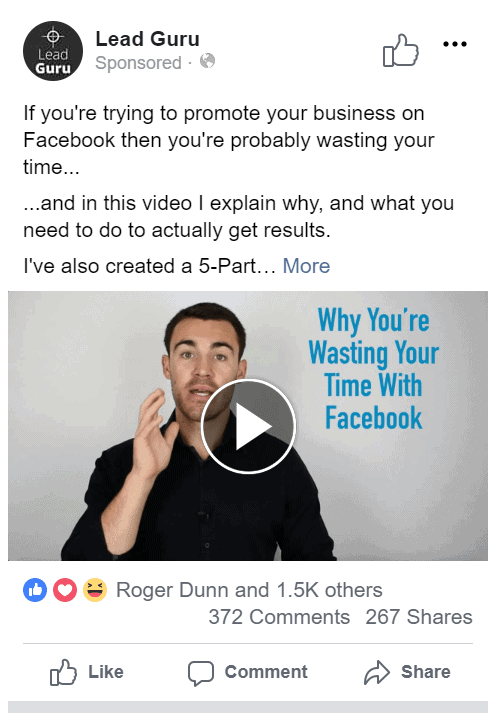
You’re far more likely to pay attention to the ad shown above than the ad below:
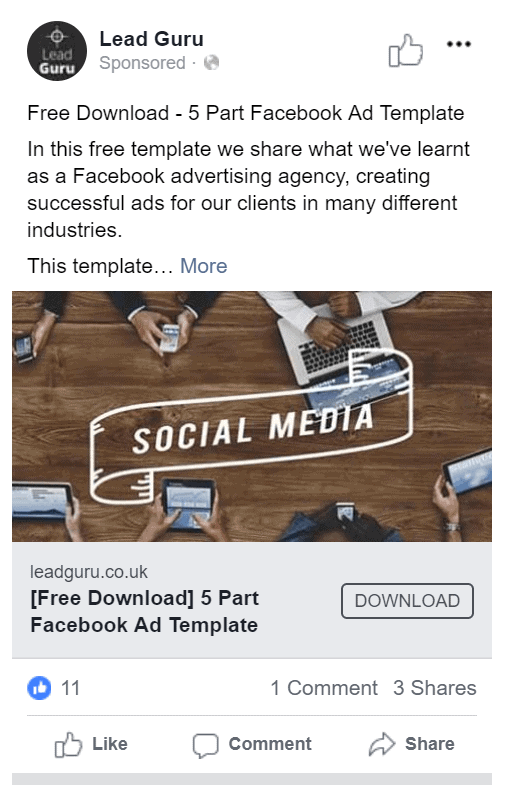
Lots of social proof is an online endorsement. And it’s particularly important for industries where you need to establish your expertise in order to make a sale or generate leads.
A quick and inexpensive way to generate social proof, is to advertise to your warm audiences first, before you push your ads out to cold audiences.
Whenever I create a new ad, I like to spend $5-10 promoting it to the people that have liked my Facebook page. That adds dozens (sometimes hundreds) of reactions within 24 hours and makes a big difference when I push my ad out to cold audiences.
#36 Ecommerce + Dynamic Retargeting = Awesome
Dynamic Retargeting campaigns are incredibly effective for ecommerce businesses.
They are very easy to set up and they provide the ultimate tailored retargeting experience.
With dynamic retargeting campaigns you can serve ads for products that people have shown an interest in on website.
In other words, if someone checks out a product of yours, you can advertise that particular product to them on Facebook.
And you don’t need to create each retargeting ad manually – for a lot of ecommerce businesses that would be insanely time consuming. Instead you just need to create a catalogue (a lot of ecommerce platforms automatically do this for you).
Don’t be surprised if your cost per purchase is 10% of what you achieve targeting cold audiences. Just remember to come back to this Facebook advertising tips post and let us know in the comments if it is.
[feature_box style=”10″ only_advanced=”There%20are%20no%20title%20options%20for%20the%20choosen%20style” alignment=”center”]
IMPORTANT: If you haven’t yet seen my FREE training on Facebook Ads Strategy, I’d strongly recommend you check it out right now:
3 Killer Facebook Ads Strategies To Double (Or More!) Your Revenue!
In it, I demonstrate 3 Facebook Advertising sales funnels that I’ve used to generate 7+ figures repeatedly for our clients.
[/feature_box]
#37 Use the Exclusion Marketing Method to Boost Facebook Ad ROI
The exclusion marketing method helps improve your Facebook advertising ROI by excluding people that have already taken your desired action.
Unless you offer a consumable product, you do not want to advertise it to people that have already bought it. That is a waste of money.
Therefore, it can be beneficial to set up your ad sets so that they exclude previous purchasers, particularly if you’re not using the conversions objective.
This video shows you exactly how to implement the exclusion marketing method:
#38 Set Realistic Expectations
I have spoken to many business owners that expect Facebook to deliver insanely low cost per lead or cost per purchase numbers. Unfortunately, that’s completely unrealistic.
Facebook advertising is a competitive marketplace and the word is out. If it was possible to print money with Facebook, then advertisers would flock to the platform and massively bid up the price.
Depending on what you offer, you are very unlikely to generate leads or sales for less than $10 each.
That doesn’t mean Facebook can’t generate fantastic results for your business. Paying $25 to sell a $100 product is a great return on investment, particularly when you factor in repeat purchases.
It’s just important to understand that there’s a difference between what you want and what you should expect.
#39 Test Lead Ads AND Conversion Campaigns
A lot of people ask me which delivers the better results when you want to generate leads – Lead ads or Conversion ads.
My advice is nearly always to test both.
Because it differs from business to business.
Usually, lead ads produce a higher volume of leads and a lower cost. Whereas conversion ads produce a lower volume of lead but a higher quality.
You’ll have to decided which is more important for you.
Here’s a short video that details my thoughts on this question:
#40 Shorten Retargeting Windows
The largest retargeting window Facebook will allow you to create is 180 days. Using this maximum length of time will create the largest retargeting audience and because of that most Facebook advertisers use it.
However, there’s a big difference between someone who visited your website within the last 30 days, than someone who visited 6 months ago.
Someone who visited your website 6 months ago and has not been back since, cannot be regarded as a warm prospect.
You’ll almost certainly see better results targeting people that visited your website within 30 or 14 days. To do this effectively, you will need to be generating a reasonable amount of website traffic.
To create a 30-day website custom audience to retarget, head to the Audiences dashboard within Ads Manager.
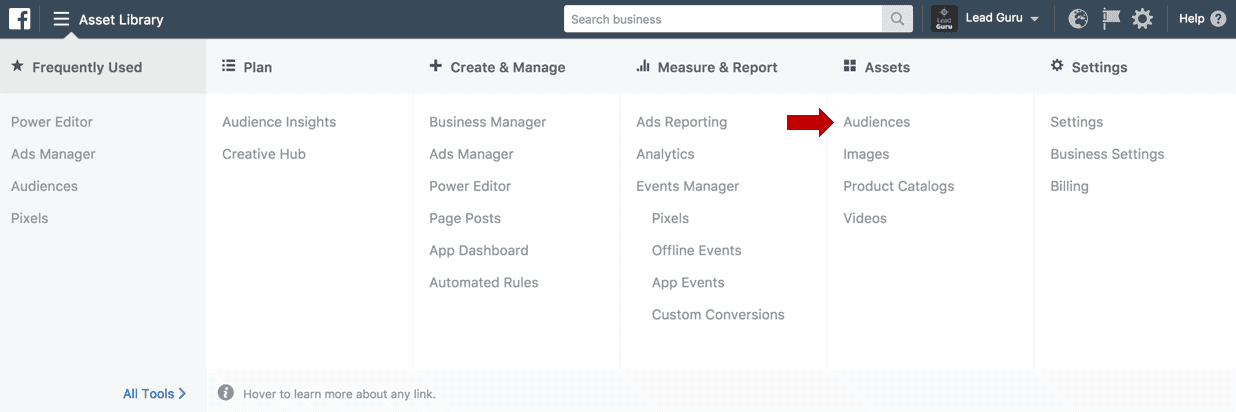
Then select Create Audience and Custom Audience from the drop-down menu:
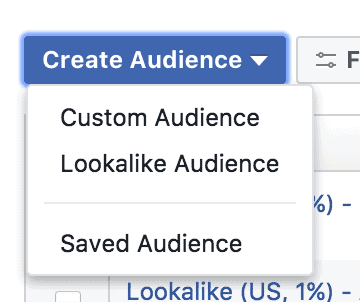
Doing so will open the following Create a Custom Audience Window:
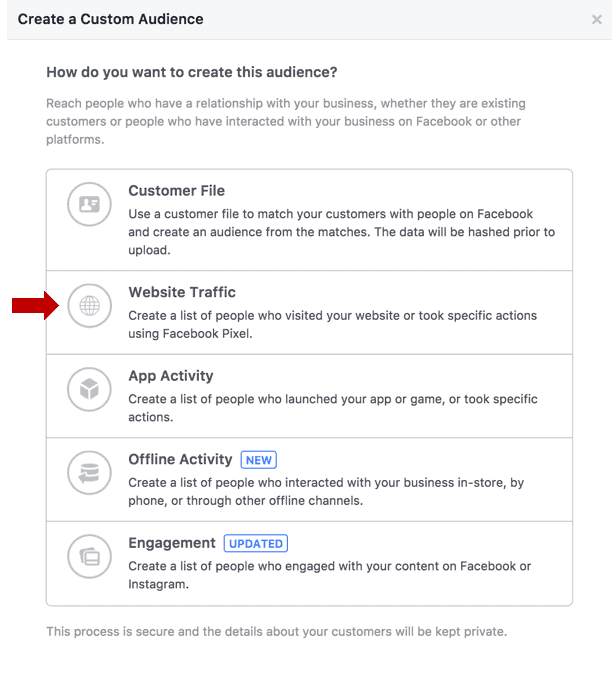
Select Website Traffic, as you can see above.
The screenshot below shows the default settings for a new website custom audience:
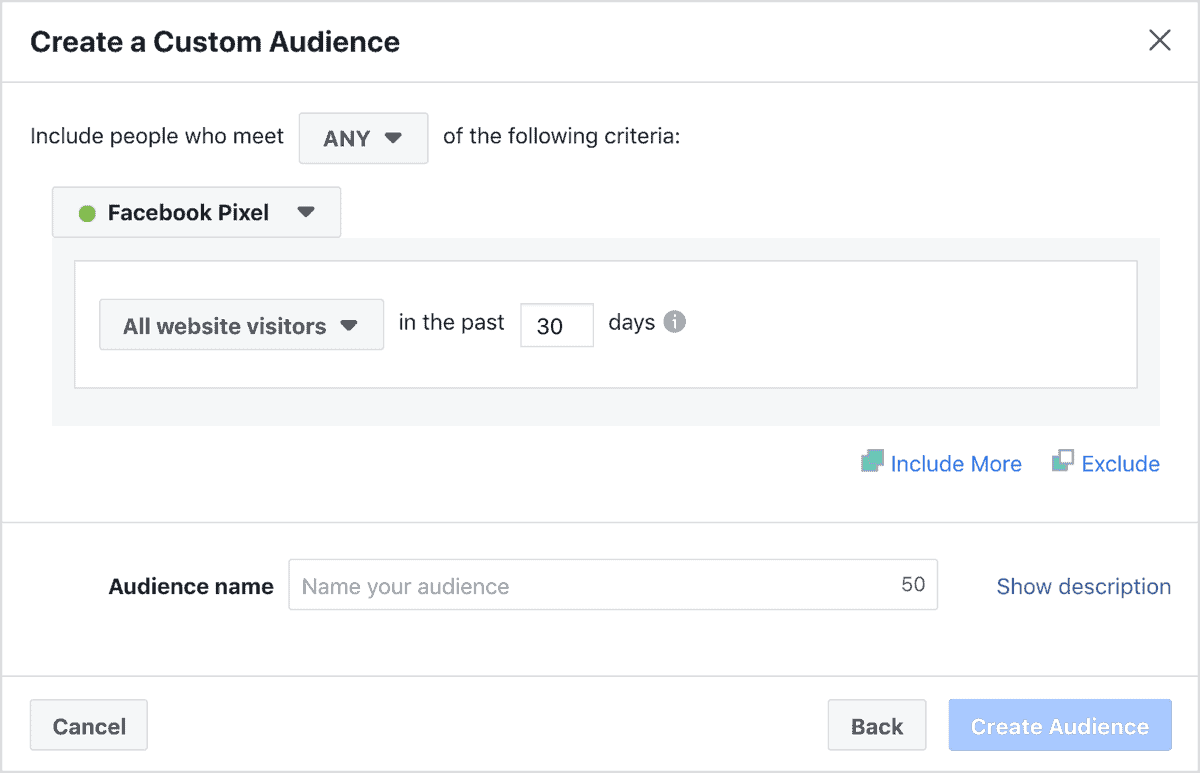
To target all website visitors, simply give this audience and name click Create Audience.
If you would like to get a bit more creative with your website visitor retargeting on Facebook then check out this article: How to Retarget Website Visitors on Facebook.
#41 Focus on What Really Matters
A lot of Facebook advertising beginners find the Ads Manager confusing and difficult to use. There is a huge amount of functionality and Facebook is adding to it all the time. This is great for us advertisers but does mean that it be very hard to see the wood for the trees.
At the end of the day there is probably 1 or 2 metrics that really matters to your business and you can more or less ignore everything else.
For example, with a lead magnet campaign it’s best of focus on your cost per lead and more or less ignore all the other Facebook advertising metrics. The same applies to purchase campaigns and lead generation campaigns.
In the above example, it doesn’t matter how high your CTR or Facebook ads relevance score is, if your cost per lead is too expensive.
#42 Follow the 20% or Less Text Rule
Facebook do not want their platform to be filled with ad images that contain a lot of text. They used to strictly disapprove any ads with images that had 20% or more covered in text. Now they will sometimes allow you to run ads that violate this rule, but they will punish you for doing so.

If you see the warning message above when you create your ads in Ads Manager, I would recommend changing your ad image. Even if your ad does run, Facebook will limit your reach and increase your CPM (cost per 1,000 impressions).
Whether you think it makes sense or not, it’s best to play it safe. When it comes to Facebook ads, what Facebook says, goes.
Occasionally you’ll see this warning message pop up incorrectly. If your ad image obviously does not contain 20% or more text then you can request a manual review and a real life human being ? from Facebook will take a look.
#43 Target Your Competitors’ Customers
If you have a superior offer to one of your competitors…
Perhaps your product or service has something theirs doesn’t…
Or you can offer a much better price…
Targeting their competitors with your Facebook ads can be extremely effective.
You know these people are in the market for what you have to offer. You just have to demonstrate that your product/service is better and the logical choice going forward.
This video shows you exactly how to target your competitors’ customers:
#44 Use Bid Caps to Limit Conversion Costs
Facebook ad bid caps tell Facebook not to bid more than a certain amount for a particular event. That event could be a lead, purchase, etc.
This doesn’t mean that you are guaranteed to generate conversions for less than your bid cap. But Facebook will stop serving your ads or reduce the amount your spending if your ads can’t achieve the number you set.
Using bid caps can really help reduce your average cost per conversion. You may want to spend $500 a day but if you can only spend $300 per day of that profitably, then it’s usually best to limit your ad spend to those elements that are performing best; bid caps do that for you automatically.
Bid caps can be particularly effective around the holidays when the cost of Facebook ads often skyrockets temporarily. For step-by-step instructions on how to use Facebook ad bid caps, check out this article: How to Use Facebook Ad Bid Caps to Prevent Skyrocketing Costs
Warning: Be careful not to set your bid cap too low. If you do, your ads probably won’t run. I think it’s best to start with a bid cap that’s double what you usually pay per event. You can always reduce it once your ads are live if need be.
#45 Use Page Posts as Ads
Social proof is an important part of Facebook advertising. Ads, such as the one below, with lots of shares, comments and reactions usually perform better than those without.

This makes sense. Social proof is an online endorsement of your ad. We all pay attention to reviews when it comes to booking hotels and restaurants and the same can be applied to Facebook ads.
Therefore it’s best to promote the same post as an ad when you advertise to multiple audiences. That way social proof will be concentrated one one ad instead of spread across 3 or 4 versions of the same ad.
The easiest way to do this, is by publishing your ad as a post on your Facebook Page. Then when you’re in Ads Manager, select Use Existing Post instead of Create Ad:
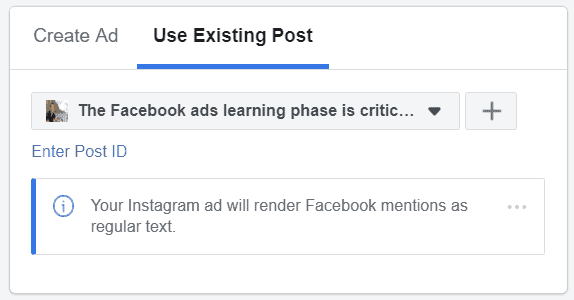
Here you can select from your Facebook Page posts.
TIP: If you don’t want to publish your ad on your Facebook Page, but you still want to use the same ad for multiple ad sets, you can select Enter Post ID:
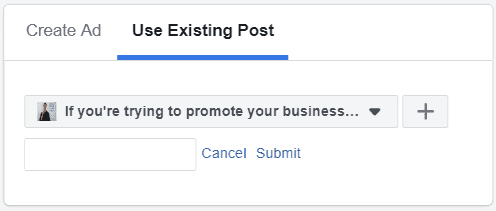
Here you simply enter your ad’s ID and click Submit.
You can find your ad ID in the Page Posts section in Ads Manager:
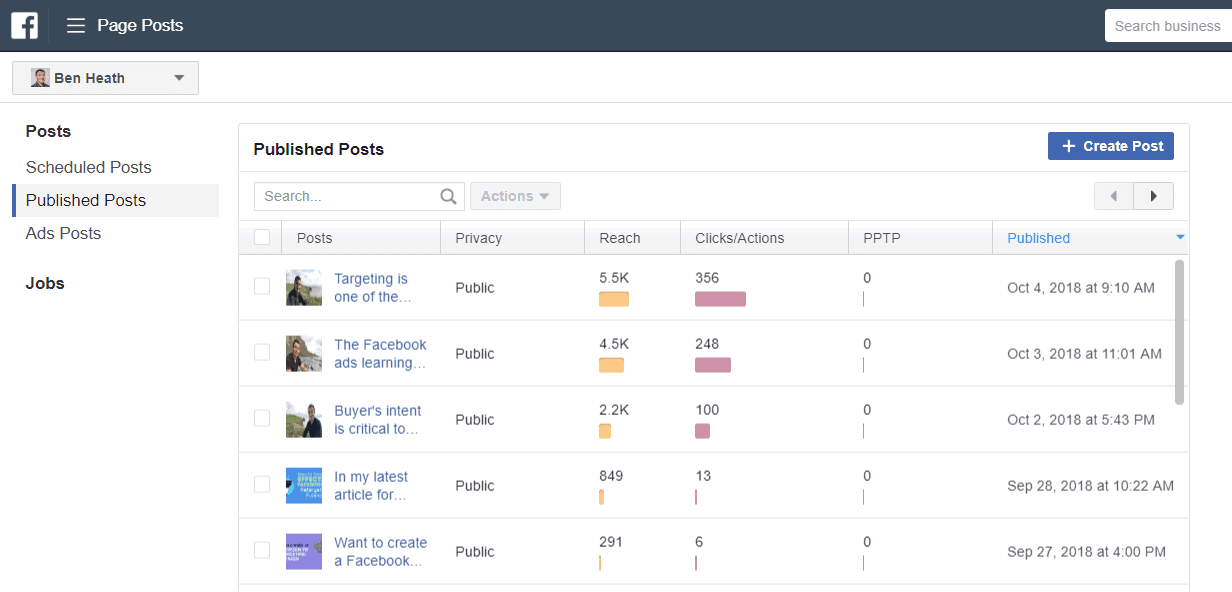
#46 Increase Your Prices
I’ve worked with a lot of ecommerce businesses that have generated a lot of traction by significantly undercutting their competition.
This can work in the short run, but small margins often mean you can’t afford to advertise consistently.
Multiple clients have told me that they need to generate purchases for less than £5 each. That cost is just not realistic for most businesses to achieve on a consistent basis and at scale.
And it shouldn’t be necessary if their average order value is £30+.
I’ve advised most of these companies to increase their prices and double their margin. That way they can afford to pay more to acquire new customers.
Sales volume might decrease a bit, but there’s no point selling a lot of stuff if you’re not making any money!
#47 Try Targeting Everyone
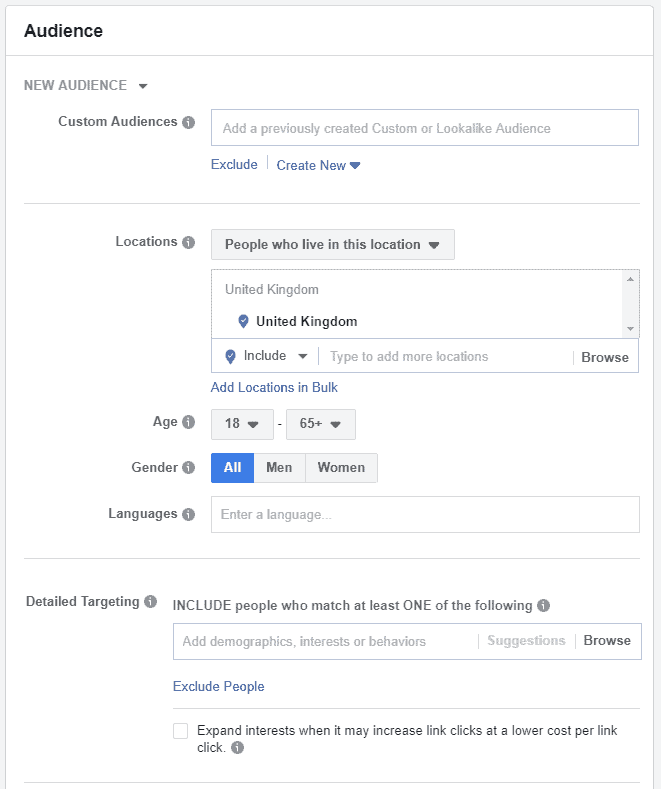
I know this sounds insane, but I’ve seen this targeting strategy work very well a number of times.
Here’s why…
Facebook is now extremely good at working out who is likely to take your desired action. In fact, their targeting algorithms are probably better at it than you are.
Therefore, in some cases it makes sense to let Facebook work it out.
Facebook advertisers usually spend a lot of time trying to work out which targeting options will deliver the best results. Specificity can deliver great results; but severely narrowing your audiences cuts out a huge amount of your potential target market.
With this strategy there a couple of things you need to be aware of:
- It works best with ad accounts that have already generated a lot of conversions. Facebook uses conversion data to work out who is most likely to convert. The more data they have, they more accurate their targeting will be.
- Be prepared for a high initial conversion cost. Facebook’s targeting algorithms are going to take some time to work it out for you.
They’ll serve your ads to different types of people and see which performs best. That learning phase takes time and conversions are likely to be expensive during it.
Just make sure you still include location targeting if you operate on a local basis or in certain areas.
(FREE RESOURCE: Download my free 5-Part Facebook Ad Template and model from proven, high-performing ads in a number of different industries)
Conclusion
Here’s the full list of Facebook advertising tips:
- Video, Video, Video, Video
- Use Automatic Placements Most of the Time
- Take Full Advantage of the Facebook Pixel
- Target Your Hyper-Responsive Prospects with Custom Audiences
- Build a Facebook Group
- Dedicate 10% of Your Budget to Brand Building
- Use Facebook Lookalike Audiences
- Get Specific with Your Retargeting Campaigns
- Sell eCommerce Products with Carousel Ads
- Create a Facebook Advertising Sales Funnel
- Use an Appropriate Ad Budget
- Don’t Forget About Facebook Page Likes
- Use the Facebook Pixel Helper Google Chrome Extension
- Start a Conversation with Your Prospects via Facebook Messenger
- Take Advantage of Campaign Budget Optimization
- Use the Lowest Cost Bid Strategy
- Keep an Eye on Ad Frequency
- Price Discounts Get People to Take Action
- Use Facebook to Build an Email List
- Offer Something People Actually Want
- Use the Right Ad Objective
- Test Different Hooks in Your Ads
- Follow Up with Lead Generation Ad Responses ASAP
- Don’t Give Up Too Early
- Spy on Your Competitors’ Facebook Ads
- Use the Call Out Method
- Don’t Distribute Ad Budget Evenly
- Structure Your Facebook Ad Campaigns the RIGHT Way
- Use Scarcity in Your Ad Copy
- Monitor Ad Relevance Score
- Include Emojis in Your Ad Copy
- Use UTM Parameters
- Don’t Adjust Your Facebook Ad Campaigns During the Learning Phase
- Create an Omnipresence Retargeting Campaign to Sell Services
- Generate Social Proof First with Warm Audiences
- Ecommerce + Dynamic Retargeting = Awesome
- Use the Exclusion Marketing Method to Boost Facebook Ad ROI
- Set Realistic Expectations
- Test Lead Ads AND Conversion Campaigns
- Shorten Retargeting Windows
- Focus on What Really Matters
- Follow the 20% or Less Text Rule
- Target Your Competitors’ Customers
- Use Bid Caps to Limit Conversion Costs
- Use Page Posts as Ads
- Increase Your Prices
- Try Targeting Everyone
So which of the Facebook advertising tips included here is your favourite?
Are there others that you think I have missed out?
Let me know in the comments section.
Post a Comment
You must be logged in to post a comment.


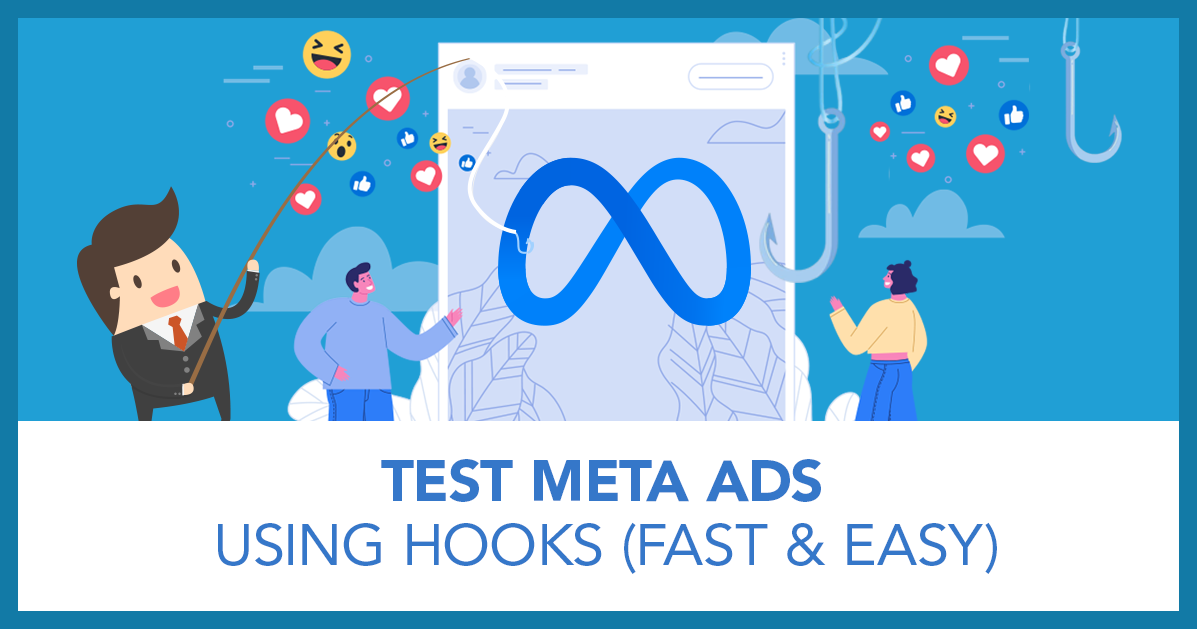
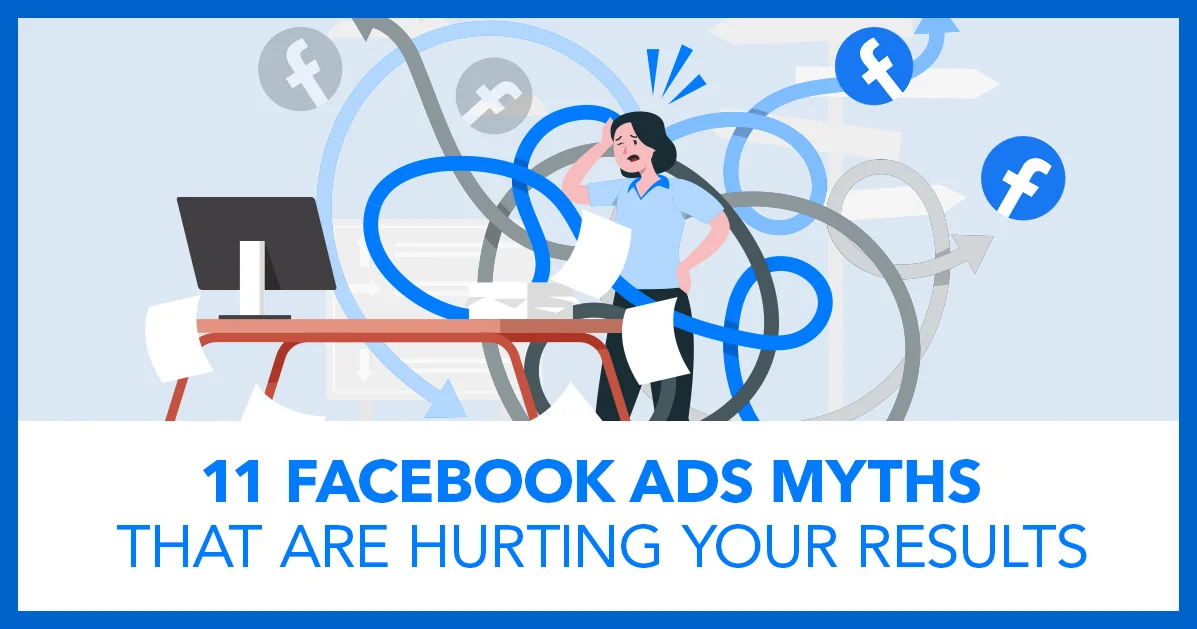
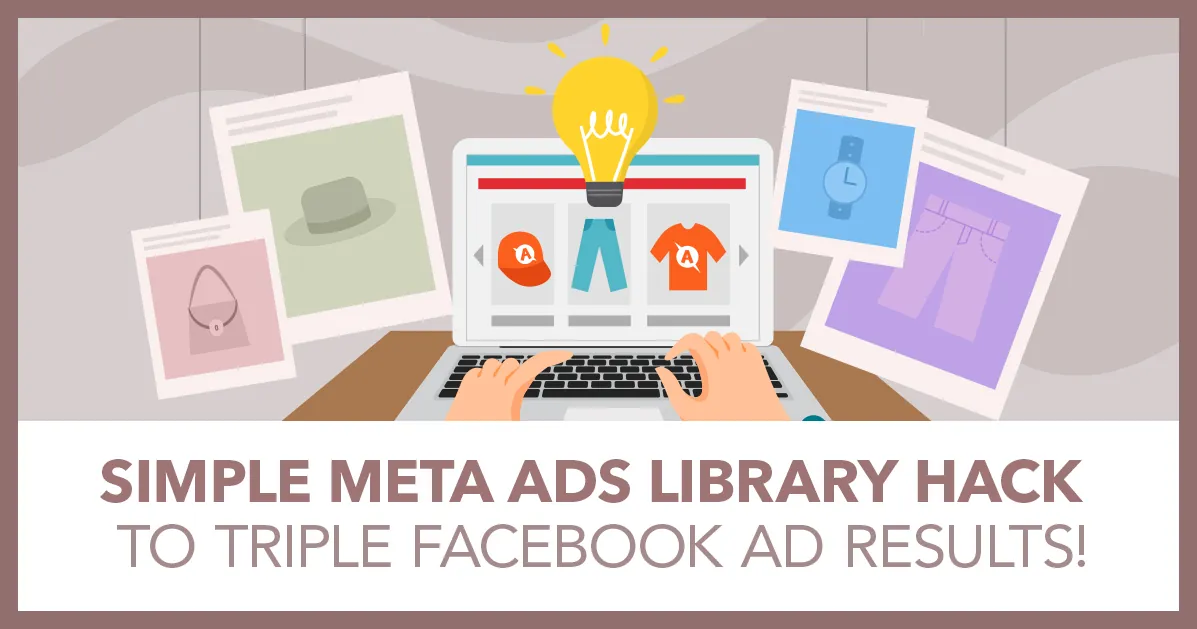
Kate
One more tip is using special Facebook tools. One of the ones I tried is LeadEnforce.com. They help you target Facebook competitor’s audience. Here you get a custom list made up of your competitor’s FB group and then use it as your audience for running ads on FB.
Ben Heath
Thanks Kate, I’ll look into it.
Nick
In addition to tip 21, following up with your leads right away. Would you follow up on a lead lets say late at night or in the weekend? If I get a lead Saturday night, should I wait till Monday morning to follow up, or rigt away?
Thanks!
Ben Heath
Hi Nick, good question. For me it depends on the business. If it’s B2B I would wait until Monday. Otherwise I would follow up over the weekend. I wouldn’t follow up in the evening though. Perhaps 10am-5pm on Saturday & Sunday.
jayant
After hiring many agencies which had not perform well, I am learning Fb Advertising by my own. Your article helps me a lot. It is really worth.
Ben Heath
Thanks a lot Jayant – glad to hear it 🙂
Toheeb
Thank you for the inspiring article sir, I have a question. In targeting everyone like you said and let Facebook take action. In my geographic Location for example so people click ads when they don’t even know what they are clicking and it keeps repeating over several ads..How do one combat that even if you use particular interest and demographics some of those uninterested individuals still Waste ads budget.. pls you can email me at [email protected] I would appreciate your reply thank you.
Ben Heath
Hi Toheeb, that’s a great question. The answer is to make sure you are using the right campaign objective. If you are using the conversions objective then Facebook will put your ad in front of people that are most likely to convert (probably not people that are just clicking on your ads for the sake of it).
Ezio
Thank you for all of the tips Ben.Help me a lot.
I got a questions about #47 Try Targeting Everyone.You said”It works best with ad accounts that have already generated a lot of conversions. Facebook uses conversion data to work out who is most likely to convert. The more data they have, they more accurate their targeting will be.”
Our websit used to sell anime product one year ago,yes,sold really well.We got about 60k sells last year.All of them came from facebook WC campaign.That’s mean we already have lots of conversions data.right?
but this year our studio decided to sell jewelry.We hide all anime products in our websit(We use the same websit)and run facebook WC campaign.Will facebook pixel confuse about the data?Our pixel do has lot of purchase data about anime,but now we use same pixel to sell jewelry.If we set up no detailed targeting in facebook wc campaign.Will facebook send us traffic base on that old anime data?
Thanks
Ezio
Ben Heath
Hi Ezio. Yes it sounds like you have a lot of conversion data there. However, because you are selling something very different, I don’t think the conversion data will apply so I’m not sure that open targeting will be very effective for this new campaign.
That said, I would still probably test it. You’ll quickly find out if it works or not.
Jo
Really great advice Ben, thank you so much! The tip on the emoji link and how to set your AD budget is very helpful.
Would you recommend adding a couple of countries into the same AD, or should you separate them? Also, whats your advice on the audience number for each campaign?
Thanks again!
Ben Heath
Thanks a lot Jo, that is great to hear.
I don’t mind targeting multiple countries in the same campaign and even same ad set. If you need to change your ad creative for each to accommodate language or cultural differences then it is best to separate them, but otherwise you don’t need to.
My rough guideline is 250k+. But local businesses will often target smaller audiences out of necessity. And national or international companies may target audiences as large as 10 million. Provided your audience isn’t too small, you shouldn’t have any issues relating to audience size.
Pingback: 20 Awesome Topics For Content Writing - Pepper Content's Blog
Pingback: The Importance of Brand Awareness: Strategies for 2021 - Design Wizard
Prasanth
Awesome Post. Very Clearly explained about Facebook Ads & Also its uses. The Way the blog is.. Its very nice with clearly mentioned Strategies. Thanks for Sharing. Please keep sharing the new Stuff regarding Facebook Ads.
Ben Heath
Thanks a lot 🙂
Thao
%article_summaty%
my blog post แทงบอล77
Karl
I am not rattling superb with English but I come up this rattling easy to read this.
Soila
%article_summaty%
Feel free to visit my webpage เว็บแทงบอล
Watsonwov
There’s even an exclusive welcome supply of 20 credit given to every new member freed from charge to study the website functionality better and take a look at the awesome potentialities offered by premium membership. The male audience appreciates affordable costs for premium options and many search filters for efficient connections. The site’s core features are chat and picture galleries. Don’t behave like you’re on the examination. What does a typical Ukrainian girl look like? Ukrainian ladies are some of the prettiest ladies in Europe and they know it, which is why you can at all times see a Ukrainian girl rocking the most flattering and slightly revealing outfits. Ladies of this nationality are often very bold and can boast of many targets and achievements. Jap European dating girls can usually give alerts to males at a subconscious degree. 2. Dear: It isn’t low cost to join any of the European dating websites.
It is possible for you to to enroll and look around at most, but you will have to subscribe to at least one paying plan to access the features. It’s because folks from a number of European international locations and regions join them. Most of these websites have a large person base so that you will get a wide number of matches from various European regions and international locations. In reality, many youthful ladies from Eastern Europe are glad to marry older males from western nations. Second, there are services that help to interact extra with Russian girls so far. They usually not solely present a giant choice of girls but in addition supply extra services that will assist you to start and maintain relationships with a Ukrainian lady. Thanks to such a pattern of shut ties within the household, a Russian lady won’t only take care of her family, however will be willing to create her personal.
Apart from, Russian brides are very romantic, typically they need to see the man’s eyes, his smile to really feel that he may actually be the one. In addition to, the messaging app works with video and audio recordsdata, so you’ll be able to hear and see your potential companion anytime. These ladies want the proper time to settle within their contemporary companion. Of course, there are some explicit features in relationship Russian ladies, but you also need to remember some general rules of being a gentleman. Speaking to single Eastern European online girls, attempt to get to know your conversation companion higher to know how one can act. You know what all ladies looking for men dream of? 4. Expectations: You may need heard about plenty of stereotypes relating to European ladies. Many guys think there is no such thing as a difference between a reside chat with Jap European ladies and real-time meetings, however males make [url=https://charmingdatefakescamreviews.tripod.com/]charmdate review[/url] some mistakes relating to shove. If you happen to ask your friends easy methods to get women, half of them will answer – make them snicker. For the primary impression, Ukrainian citizens will first discover your clothes and then your face. You can find that for signing up, you’ll have to typically go to the home web page and then click on on the sign-up or register possibility there.
In fact, it is essential to ask him if the place you’ve chosen is suitable for him too. Don’t be so fast to invite a woman to your place or get near her somehow. In this text, you get the compilation of the widespread courting rules to make a Ukrainian woman fall in love with you. Russian girls take nice satisfaction in their culture and traditions, so displaying genuine admiration for them will definitely make a positive impression. Many Russian girls who be a part of these relationship sites are also aware of the many men who join fraudulently and are the truth is scammers themselves. As an illustration, they’re very impressionable and may reveal rather a lot of different ideas. Resulting from this, you can have many options and matches from the various areas of European dating. Before beginning your romantic journey, it is sensible to discover a trustworthy European dating platform you can depend on.
Suzanne
Heya i’m for the first time here. I came across this board and I find It really useful &
it helped me out much. I hope to give something back and help others like
you helped me.
Also visit my page: แทงหวยออนไลน์